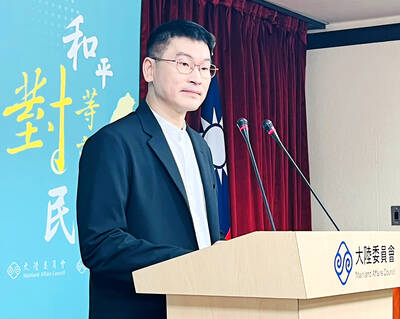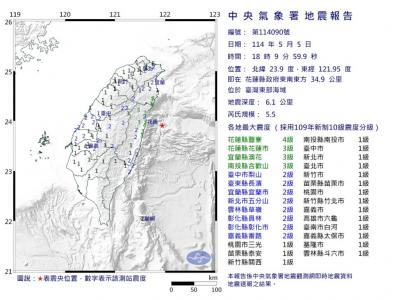Liberty Times: What do you think are the strategic calculations behind China’s unilateral announcement of the ADIZ?
Joanne Chang (裘兆琳): Chinese President Xi Jinping (習近平) has repeatedly mentioned his “Chinese dream” and called for the establishment of a “new type of major-power relationship” between the US and China, saying that the Pacific Ocean is large enough to accommodate the two great powers.
The most important question is: How exactly does the new Chinese president plan on fulfilling that “dream?”
China established a state security committee after the conclusion of the third plenary session of the Chinese Communist Party’s 18th Central Committee on Nov. 12. Now it is time for it to execute its plans one by one.
Over the past years, Japan has made several moves to bolster its claims over the contested Diaoyutai Islands (釣魚台). It expanded its ADIZ [in the East China Sea by 22km] in June 2010 before nationalizing the archipelago in September last year. Such provocative moves have prompted China to put even more thought into mapping out countermeasures against Japan’s aggression. Their relationship has tensed up drastically as a result, with China urging Japan to acknowledge the existence of a territorial dispute over the island chain.
Japanese media reported recently that China now intends to make the 12 nautical mile [22.2km] zone off the islands an off-limits area [to all vessels], a goal I believe was set after careful consideration of a number of other options.
China announced the new ADIZ line on Nov. 23, the date when the 1943 Cairo Conference began in Egypt. Hours after the announcement, news emerged that the P5+1 countries [in reference to the five permanent members of the UN, the US, the UK, Russia, China and France, as well as Germany] had reached a six-month interim agreement with Iran in Geneva to curb its nuclear program.
Over the past few months, peaceful settlement of disputes, be it the Israel-Palestine conflict, Syria’s chemical weapons issue or Egypt’s political stalemate, has become mainstream in the international arena. A trend that leads me to believe that China’s ADIZ announcement was meant to help it gain more leverage in future negotiations with the US and Japan in the Diaoyutai Islands dispute.
China’s ambition to develop a relationship [with the US] can be seen from a speech given by its foreign minister Wang Yi (王毅) [in Washington] in September, in which he said there was vast room for US-China bilateral cooperation, such as on regional hotspot issues regarding Iran, North Korea, Syria and even Afghanistan. In the meantime, China expressed hope that the US could respect its “core interests” that include Taiwan, Tibet, Xinjiang and the South China Sea, as well as the strategically important Diaoyutai Islands.
However, actions always speak louder than words. It is likely that China made the move [announcing the ADIZ] only to see how the US would react.
LT: What kinds of negotiation strategies do you think China adopted [in announcing the ADIZ]?
Chang: There are various types of international negotiations, but the most difficult kind is the one that aims to redistribute regional resources or, in other words, to change the “status quo” in a specific area.
Such a negotiation is often initiated by an aggressive nation with the aim of forcing other concerned parties to positively respond to its demands. One of the approaches is to create a sense of urgency by stirring up regional crises, allowing it to push others into talks on issues of its own choosing.
For example, China’s countermeasure against Japan’s refusal to acknowledge the Diaoyutai Islands’ disputed status is to dispatch coast guard vessels to sail straight into the territorial waters of the archipelago for what it said were “routine patrol operations.” According to Japanese government statistics, since September last year, Chinese vessels have been spotted 71 times within the 12 nautical mile zone off the islands and 294 times in its surrounding waters. China has also deployed surveillance aircraft to the island chain in an apparent attempt to assert sovereignty.
Now with the declaration of its ADIZ, China is likely to follow the same strategic pattern as Japan and start calculating the number of times the disputed archipelago is “intruded” on by foreign aircraft and vessels from Japan, the US and other nations. It may use the information to buy itself more bargaining chips at the negotiation table.
Moreover, the US, Japan and South Korea’s joint refusal to submit flight plans to China before entering its ADIZ will only give Chinese fighter jets justification for ignoring the air-defense zones declared by other nations.
Nevertheless, China will still pay a price for its “surprise move,” which left a lasting [negative] impression on the US.
Although Washington is unlikely to back down in its determination to protect the freedom of navigation [in the East China Sea], it should sit down with Tokyo, Seoul and Taipei to seek ways to maintain peace and stability in the region. They should discuss the issue of overlapping ADIZs, strike a consensus on whether to distinguish between civilian and military aircraft, and lay down coordination rules for aircraft operating in the region to prevent avoidable damage and casualties.
The US is also expected to better implement its policy of “rebalance” towards Asia and further reinforce the US-Japan-South Korea trilateral relationship.
LT: Please analyze the potential repercussions for Taiwan from China’s ADIZ declaration, and tell us what you think the nation should do in a situation like this.
Chang: We must not handle the situation as if it only concerns the US, Japan and Korea, because aside from the Diaoyutai Islands, China also claims sovereignty over Taiwan and the South China Sea, and it is reportedly planning to set up other ADIZs after completing relevant preparations.
So far, four aircraft carriers dispatched by the US, China and Japan have sailed through the politically sensitive waters of the Taiwan Strait and the South China Sea. The risk of a [military] conflict in the region has greatly heightened as the nations’ struggle for air and sea control over the area intensifies.
Taiwan’s stance on the territorial disputes have long been the focus of international attention. If we handle the situation properly, we could open up new opportunities for ourselves. But if we choose to adopt a “none-of-my-business” attitude, our allies may turn their backs on us when we are browbeaten by China.
Former US National Security Council senior director for East Asian affairs Jeffrey Bader said [in his book Obama and China’s Rise: An Insider’s Account of America’s Asia Strategy] that the growing disparity between the militaries on the two sides [of the Taiwan Strait] meant it was increasingly unrealistic to think the US could provide Taiwan with weapons sufficient for its defense.
China not only possesses nuclear arms, but has also been one of the world’s largest importers of conventional weapons since 2003. What can we do about this growing [cross-strait military] imbalance?
China’s intention to enter political talks with Taiwan has become increasingly apparent, as evidenced by Xi’s statement [at a closed-door meeting with former vice president Vincent Siew (蕭萬長) in Indonesia in October] that the cross-strait political division must not keep being passed on from generation to generation.
We cannot but ask ourselves: What military, economic, diplomatic means will China employ to coerce Taiwan into meeting its demands? Will there be a role for Taiwan in the negotiations between China, Japan and the US on the establishment of rules for aircraft operating within ADIZs? Will China also submit to us the flight plans of its airplanes passing through our ADIZ? How should the two sides of the Taiwan Strait deal with the overlap of their ADIZs?
In the face of the many national security challenges, we must handle the aftermath of China’s ADIZ demarcation with a no-nonsense attitude and prepare ourselves for any possible changes the move could bring to the international environment.
The ruling party [the Chinese Nationalist Party (KMT)] should lead the way by pushing lawmakers across party lines into reaching consensuses on major diplomatic, economic and national defense issues and mapping out countermeasures.
Translated by staff writer Stacy Hsu

An essay competition jointly organized by a local writing society and a publisher affiliated with the Chinese Communist Party (CCP) might have contravened the Act Governing Relations Between the People of the Taiwan Area and the Mainland Area (臺灣地區與大陸地區人民關係條例), the Mainland Affairs Council (MAC) said on Thursday. “In this case, the partner organization is clearly an agency under the CCP’s Fujian Provincial Committee,” MAC Deputy Minister and spokesperson Liang Wen-chieh (梁文傑) said at a news briefing in Taipei. “It also involves bringing Taiwanese students to China with all-expenses-paid arrangements to attend award ceremonies and camps,” Liang said. Those two “characteristics” are typically sufficient

A magnitude 5.9 earthquake that struck about 33km off the coast of Hualien City was the "main shock" in a series of quakes in the area, with aftershocks expected over the next three days, the Central Weather Administration (CWA) said yesterday. Prior to the magnitude 5.9 quake shaking most of Taiwan at 6:53pm yesterday, six other earthquakes stronger than a magnitude of 4, starting with a magnitude 5.5 quake at 6:09pm, occurred in the area. CWA Seismological Center Director Wu Chien-fu (吳健富) confirmed that the quakes were all part of the same series and that the magnitude 5.5 temblor was

The brilliant blue waters, thick foliage and bucolic atmosphere on this seemingly idyllic archipelago deep in the Pacific Ocean belie the key role it now plays in a titanic geopolitical struggle. Palau is again on the front line as China, and the US and its allies prepare their forces in an intensifying contest for control over the Asia-Pacific region. The democratic nation of just 17,000 people hosts US-controlled airstrips and soon-to-be-completed radar installations that the US military describes as “critical” to monitoring vast swathes of water and airspace. It is also a key piece of the second island chain, a string of

The Central Weather Administration has issued a heat alert for southeastern Taiwan, warning of temperatures as high as 36°C today, while alerting some coastal areas of strong winds later in the day. Kaohsiung’s Neimen District (內門) and Pingtung County’s Neipu Township (內埔) are under an orange heat alert, which warns of temperatures as high as 36°C for three consecutive days, the CWA said, citing southwest winds. The heat would also extend to Tainan’s Nansi (楠西) and Yujing (玉井) districts, as well as Pingtung’s Gaoshu (高樹), Yanpu (鹽埔) and Majia (瑪家) townships, it said, forecasting highs of up to 36°C in those areas